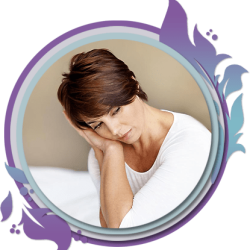What is premature menopause?
Premature ovarian failure
Premature menopause or premature ovarian failure are generally used to describe the same condition. One of the major differences between natural menopause and premature menopause is that natural menopause usually occurs between the ages of 53 and 51.
Age is an important and key factor. Early ovarian failure occurs naturally at a younger age than natural menopause, usually in the 20s, 30s or 40s. Premature menopause to describe menopause before the age of 45 and POI usually occurs when the age is less than 40 years.
A simple definition of POI is that at 45 years of age and older, the ovaries are not working properly. The ovaries stop or reduce egg production. The ovaries are also unable to produce the hormones estrogen and progesterone, which help women’s health.
But POF, which occurs at a young age, is different from menopause, which occurs at the age of 52. In POF, however, ovarian function does not stop completely. This means that the function of the ovaries fluctuates over time.
Factors causing POF:
POF occurs for several reasons. A type of POF called self-POF is called idiopathic. Some of the causes of this disease are:
Autoimmune disease:
Autoimmune disorders are conditions in which the body’s immune system can attack the body’s own tissues. If the attack is on the ovaries, it can lead to POF. It is estimated that about 5% of women develop POF due to autoimmune disease. POF is also associated with other autoimmune disorders such as hypothyroidism, type 1 diabetes and Addison’s disease.
Genetic causes:
Genetic disorders due to the lack of x chromosome (turner syndrome) are the main causes of POF, which affects the function of hormones.
Infection:
There have been reports of POIs after infectious diseases such as mumps, tuberculosis and malaria, which are very rare.
surgery:
Surgery to remove the ovaries before the age of 40 is another form of POF. This sudden elimination of ovarian hormones often leads to the sudden onset of menopausal symptoms. Ovarian removal (with or without hysterectomy) can be due to a variety of reasons, including ovarian cancer, ovarian cysts, endometriosis, or Menstruation syndrome. We hope that this type of surgery is planned in advance so that you have the opportunity to consult with your doctor about hormone replacement options, shortly after surgery, to minimize the symptoms of menopause.
cancer treatment:
Other treatments for cancer, such as chemotherapy or radiation therapy, can cause permanent or temporary damage to the ovaries. The chances of ovarian damage induced by chemotherapy depend on factors such as the type of chemotherapy drug, the duration of treatment, and the location of the radiotherapy and the patient’s age.
Hormones:
Estrogen:
Estrogen is the main female sex hormone Discharge by the ovaries and is vital for the growth of eggs and the process of reproduction. This hormone plays an essential role in maintaining the health of the heart and arteries and bones in harmony with other tissues throughout the body.
Estrogen is not just a hormone, but a combination of three hormones:
Estradiol is the main and strongest part of estrogen, which plays a major role during puberty. This hormone causes the uterus to enlarge and thicken the lining of the wall (endometrium). The ovaries also send signals to the hypothalamus and pituitary gland to stimulate ovarian follicles and slow down the production of follicle-stimulating hormone (FSH). Estrogen is produced by the adrenal glands and fat cells that produce estrogen. Estradiol from Sterile and estriol. are produced by the liver.
Progesterone:
Progesterone is a female hormone produced by the ovaries. One of its most important tasks is to help maintain the pregnancy. In the second half of the menstrual cycle, this hormone is discharge by the corpus luteum and sends a signal to the uterus to release the egg.
Follicle-stimulating hormone (FSH):
The hormone FSH is secreted by the pituitary gland to stimulate the ovaries. By secreting this hormone, the follicles begin to grow. At first, with the low secretion of these hormones, the follicles do not respond, which causes the pituitary gland to secrete more FSH.
FSH above 30 means a diagnosis of POF, but should be repeated 4 to 6 weeks later.
LH – Luteinizing hormone
This hormone is secreted by the pituitary gland and enters the bloodstream and causes ovulation, which means that the active follicles burst and the egg is released. The follicle sac is ruptured, yellowed, and called the corpus luteum, which produces progesterone. In POI, LH levels are high but lower than FSH.
testosterone
Although testosterone is known as a male hormone, it also plays a very important role in women, the most important of which are sexual health, sexual desire, bone strength and energy. About half of testosterone is produced by the ovaries and the other half by the adrenal glands. Testosterone levels gradually decrease with age, but in some cases, removal of the ovaries through surgery can result in a sudden 50% drop. Research has shown that women who have a POF, have lower testosterone levels than women of the same age.



